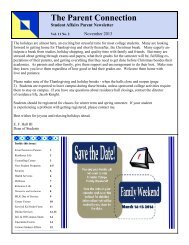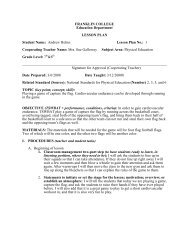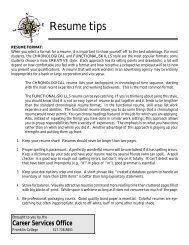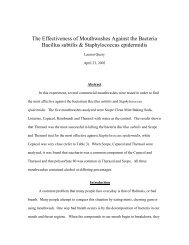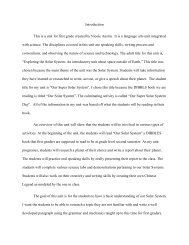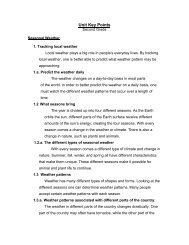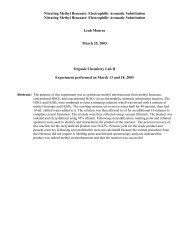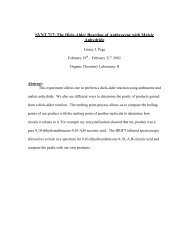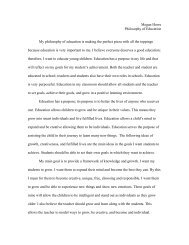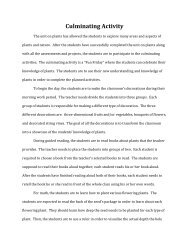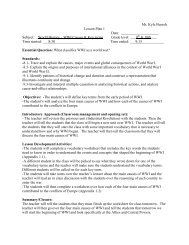Literacy - Franklin College
Literacy - Franklin College
Literacy - Franklin College
You also want an ePaper? Increase the reach of your titles
YUMPU automatically turns print PDFs into web optimized ePapers that Google loves.
<strong>Franklin</strong> <strong>College</strong><br />
Education Department : Lesson Plan<br />
Student Name: Elizabeth Curtis Lesson Plan No. 1<br />
Cooperating Teacher: Mrs. Susan Sloop Subject Area: <strong>Literacy</strong><br />
Grade: 1 st<br />
Signature of Approval: _________________________________________________________<br />
Date Prepared: 15 October 2006 Date Taught: 18 October 2006<br />
Related Standard<br />
1.3.1 – Identify and describe the plot, setting, and characters in a story. Retell a story’s<br />
beginning, middle, and ending.<br />
Source<br />
Indiana’s Academic Standards<br />
Topic<br />
Sequence of Events<br />
Objective<br />
After reading, making predictions, and discussing the book as a group, students should<br />
individually be able to retell the story by cutting and pasting the events in sequential order which<br />
will then be collected and informally assessed for comprehension.<br />
Materials<br />
Teacher: book: There Was An Old Lady Who Swallowed A Fly by Simms Taback; character<br />
worksheet; sequence of events worksheet; colored and cut out characters from the character<br />
worksheet (to retell the story as a group); tape<br />
Students: pencil; glue; scissors; crayons<br />
I. Procedures:<br />
A. Management:<br />
a. I will ask the students to join me on the floor in the front of the<br />
classroom. They should be sitting “on their pockets, spoons in your<br />
bowl.”<br />
b. If students are having trouble sitting still we will all stretch for one<br />
minute and then try sitting quietly again.<br />
B. Set: Begin with this question: “Has anyone ever accidentally swallowed a bug?”<br />
Allow several students to answer. Then introduce the book There Was An Old Lady<br />
Who Swallowed A Fly. Ask students to help identify the title and author of the book.
Also ask them to listen very carefully because at the end the teacher will need help<br />
retelling the story.<br />
C. Instructional Steps:<br />
1. Read the book to the students. Stop and talk to the students about rhyming<br />
words when they are presented in the story.<br />
2. Before going on to the next page ask students to predict what they think the<br />
old lady will do next. Ex. What animal will the old lady have to swallow next<br />
to chase the bird?<br />
3. Throughout the story review why the old lady swallowed certain animals.<br />
(spider to catch the fly)<br />
4. Put the book aside and get out the colored characters. Tell the students that<br />
you need their help retelling the story.<br />
5. Begin the retelling “There was an old lady who swallowed a fly…” Tape the<br />
old lady and the fly onto the chalkboard.<br />
6. Continue retelling the story. “There was an old lady who swallowed a<br />
_____...” Ask a student to fill in the blank and allow him/her to tape up the<br />
spider.<br />
7. Continue until all the characters have been sequenced in proper order.<br />
Congratulate and thank the students on such a great job of retelling the story.<br />
8. Hold up a Character worksheet and a “Sequence of Events” worksheet for all<br />
the students to see. Explain that they are to color the characters, then cut them<br />
out and glue them on “Sequence of Events” worksheet in the correct order<br />
(just like we did together as a class).<br />
9. Dismiss students to return to their seats and hand out the worksheets.<br />
Circulate around the room as students work. Remind them to put their names<br />
on the top of the worksheet and collect them when the students are finished<br />
for an informal assessment (to check for understanding).<br />
II. Assessment:<br />
The students will be informally assessed by way of their completed “Sequence of Events”<br />
worksheet. Students will receive a check for a correct and complete worksheet and will be asked<br />
to redo the worksheet (with help if needed) if the events are out of order. Students may have<br />
extra time to work if they need it.<br />
III. Extension:<br />
Students who understand the idea of sequencing events can “rewrite” then ending of There Was<br />
An Old Lady Who Swallowed A Fly. They can rewrite it with words or with pictures, but instead<br />
of dying (which is really sad) the little old lady lives on. Does she swallow another animal? Do<br />
the animals she has already swallowed get out of her stomach? The ending is up to the student.<br />
IV. Remediation:<br />
For a student who does not understand the concept of sequencing events, ask him to tell you his<br />
morning routine. Write his/her routine in steps (step 1; step 2). Cut the steps into strips and ask<br />
her to put the steps in order. Since it is her daily routine, she should be able to tell you again<br />
what she does first, second, third, etc. Allow him to illustrate the steps if time allows.
V. Homework Assignments<br />
If I were going to assign homework, I would ask each student to fill in the blank “There was a<br />
little boy/girl who swallowed a ________________.” Along with filling in the blank, students<br />
must also illustrate their sentences. Then I would make a class book of all the pictures.



